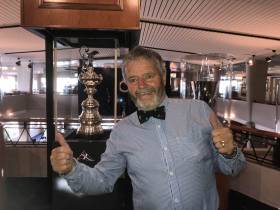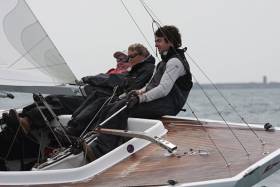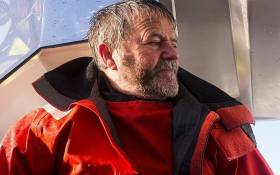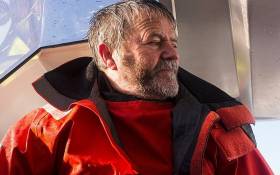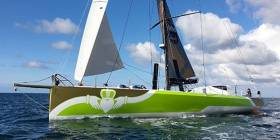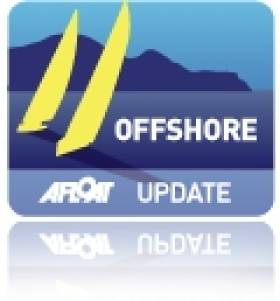Displaying items by tag: Kilcullen Voyager
America’s Cup For Ireland? Enda O’Coineen Makes ‘Challenge’ During NZ Visit
Is Ireland about to mount a challenge for the America’s Cup?
No so fast — the photo above is just Enda O’Coineen posing with the Auld Mug as it sits prude of place in the clubhouse the Royal New Zealand Yacht Squadron in Auckland.
Former Vendée Globe contender O’Coineen was invited to the home of this year’s America’s Cup winners yesterday (Friday 24 November) along with the rest of Kilcullen Voyager Team Ireland as they paused their summer circumnavigation of New Zealand.
The trip comes ahead of O’Coineen’s ‘unofficial’ completion of his previously abandoned solo round-the-world effort, as he joins the race to Les Sables from 25 January.
But first comes a return to Ireland next week for the launch of Kilcullen Voyager Team Ireland’s Schools Adventure programme, a workshop on using ocean adventure in education, a reception hosted by the French ambassador — indeed a packed calendar of events in the run-up to Christmas.
Meanwhile, with an offshore specialist like O’Coineen in charge, and a strong Irish contingent in the current Volvo Ocean Race who might feasably lend their talents, maybe an Irish America’s Cup team isn’t such a pipe dream after all…
Neil O’Hagan Talks Tall Ship Plans, Enda’s Vendée Globe Challenge & More At Greystones SC Next Week
#SailingTalk - The next event in Greystones Sailing Club’s Winter Wednesdays series of talks hosts Neil O'Hagan of the Atlantic Youth Trust, the project that aims to bring about Ireland's next sail training tall ship.
O’Hagan is also on-shore co-ordinator for Kilcullen Team Ireland in the Vendée Globe, and he will have all the scuttlebutt on the highs and lows of Enda O’Coineen sailing Kilcullen Voyager, Ireland’s first entry in the round-the-world solo yachting challenge.
The date for diary is next Wednesday 25 January at 8pm, bar open from 7.30pm. You won’t want to miss it!
Replacement Mast Gets Enda O’Coineen One Step Closer To Record Books
#VendéeGlobe - Just days after admitting his “dream is shattered” after his dismasting off New Zealand at the halfway mark of the Vendée Globe, Irish skipper Enda O’Coineen is already preparing for a return to the water.
And as the Otago Daily Times reports, that’s all thanks to the kindness of Dunedin local Blair McNab, a plumber and yachtsman who read about the 61-year-old sailor’s plight and donated him a spare 9m mast.
Though smaller than his original rig, O’Coineen said it should be enough to get him to Auckland, where a replacement mast up to the task of the round-the-world offshore challenge might be sourced.
That would enable the first-time Vendée entrant to complete the route and sail Kilcullen Voyager back to Ireland, even if he’s no longer in official race contention.
"I’m the first Irishman to sail single-handedly halfway around the world — I’ve just got to do the other half,” he said.
The Otago Daily Times has more on the story HERE.
#VendeeGlobe - Enda O’Coineen says “it's a real possibility to finish what I started” despite the devastating mast break that took him out of the Vendée Globe on New Year’s Day.
The Kilcullen Voyager helm was forced to cut the rig free to protect the hull after dismasting some 180 nautical miles south-east of Dunedin in New Zealand — ending Ireland’s first ever challenge in the round-the-world solo yacht race at the half-way point.
In his final race log, the 60-year-old businessman described how the incident left him “shaken and struggling to get back to New Zealand”, with no motor on board and many miles from rescue.
However, 40-knot winds over the last few days helped to push his drifting vessel into range of a Dunedin trawler, on board which he was expected to reach land this morning (Friday 6 January).
Speaking to the Press Association ahead of his arrival, he confirmed comments from his last log that he wants to complete the race course, even if he is formally out of competition.
"It's a real possibility to finish what I started but it's a massive undertaking to do the repair," said Afloat.ie’s Sailor of the Month for December. "But I'm nervous about saying I'm going to do that.
“Doing that, resourcing it, making it happen, there's a lot of sacrifice for the family and all of that but that's one real alternative I'm contemplating."
Replacing the rig is one of three options open to O’Coineen, which include shipping the broken boat home, or leaving it behind.
Enda O'Coineen Races Past Remote Southern Ocean Island (VIDEO)
Ireland's first ever entry in the non–stop race around the world continues its Southern Ocean passage in the Vendee Globe Race.
After four weeks at sea, Enda O'Coineen (60) was passing the most remote Atlantic Island Tristan del Cuna on December 1st. O'Coineen admitted he is looking forward to leaving the South Atlantic in his wake and entering the Indian Ocean in a global voyage that will see him at sea until March.
O'Coineen opened a new chapter in Irish offshore sailing when he started the French race on November 6. His entry, he hopes, will bring a new wave of young Irish sailors into offshore sailing.
The Galway Bay adventurer is Ireland's first entry into the 'everest of sailing', the sports toughest marathon with a high attrition rate.
In his own words O'Coineen says 'to finish the 40,075 km race will be to win it'.
He qualified to race by virtue of his third place finish In 2015 when he made it to the podium of the St Barth-Port La Forêt transatlantic race on an IMOCA (he finished third)
D27 : Images from Enda O'Coineen / Vendée Globe by VendeeGlobeTV
Strong Irish Presence In Latest Vendée Globe
#VendéeGlobe - Enda O’Coineen’s homegrown entry is not the only Irish connection in the latest Vendée Globe, as the Irish Examiner reports.
In fact, three other Irishmen have significant mangerial involvement in the round-the-world yachting challenge, which began on Sunday 6 November as the fleet set off from Les Sables.
Apart from Cork’s Stewart Hosford, chief executive of the Alex Thomson Racing/Hugo Boss team, there’s also Marcus Hutchinson from Kinsale, who is team director for French contingent SMA.
Meanwhile, Dubliner (by way of Japan) Tony O’Connor is general manager of the Japanese team Spirit of Yukoh, sailing the reconditioned Hugo Boss act that finished third in the last Vendée Globe in 2013.
The Paul Meilhat-skippered SMA is currently the best of these boats in third position, with Hugo Boss in seventh, Spirit of Yukoh 19th and O’Coineen’s Kilcullen Voyager in 26th following a premature start on Sunday.
O'Coineen's IMOCA 60 Kilcullen Voyager Makes Gains in Transat Fleet
He started with a 24 hour disadvantage due to engine problems but after a week at sea Irish solo sailor Enda O'Coineen has hauled himself back into the Transat St Barth – Port la Foret race and now trails the fleet by only 55 nautical miles. In seventh place, the Galway Bay sailor is closing in on Canada's Eric Holden. It's been a great debut performance for the IMOCA 60 Kilcullen Voyager and it looks like there will be more gains for the Irish yacht due to the injury of the fleet leader. Paul Meilhat is currenlty awaiting airlift by helicopter.
Yesterday, Meilhat was seriously injured during a manoeuvre. At the time, IMOCA60 SMA was sailing downwind under mainsail alone and two reefs, around twenty miles to the south-west of the Azores archipelago, in 50 knots of wind and 8 metre waves. Paul immediately contacted his team to alert them about the incident: he has pain in the ribs, the hip and the right leg.
Race Management for the Transat Saint-Barth / Port La Forêt and the MRCC in Ponta Delgada (Maritime Rescue Coordination Centre) were alerted straightaway. Initially, Paul and his team decided to find 'shelter' for the boat in the lee of the island of Sao Miguel.
At 15:30 GMT, when Paul confirmed that he was having considerable difficulty moving himself around the boat, the emergency services were triggered. The patrol boat from the Portuguese navy, Viana Do Castelo, heads to the zone. However, the weather conditions are such that it is not possible to envisage an airlift by helicopter or a vessel to come alongside in the immediate future.
SMA is currently barepoled and is drifting offshore at around 6 knots, escorted by the navy patrol boat, which will remain alongside him throughout the night. Paul is in permanent contact with his team and with the medical department in Lorient, Brittany.
Today, Tuesday, once the low currently plaguing the zone around the Azores has shifted over to the East, the weather conditions will improve and Paul can be airlifted by helicopter. SMA's team is on its way and will be in Sao Miguel at around lunchtime local time tomorrow, Tuesday.
#Open60 - There was plenty of action on the water in and around Cork Harbour this afternoon (Sunday 12 July) as the Atlantic Youth Trust's IMOCA 60 Kilcullen Voyager took on the Alex Thomson-skippered Hugo Boss in a special challenge race as part of this weekend's SeaFest events.
Indeed, it's not every day Cork Harbour plays host to not one, but two of the world's highest performing ocean racing yachts - particularly one with a record-breaking offshore pedigree, and the other sailing with youth sail trainees taking up a once-in-a-lifetime opportunity to get on-deck experience at sailing's pinnacle.
Despite the relative lack of experience on the Irish boat, they certainly gave Thomson and crew a run for their money today, closing a significant gap to cross the finish line only a minute or so behind the professionals.
Hugo Boss well ahead of Killcullen, currently about 3 miles south of Roches Point @Seafest_ie pic.twitter.com/aW1L51l0Mm
— Gavin Deane (@gavinroyalcork) July 12, 2015

























